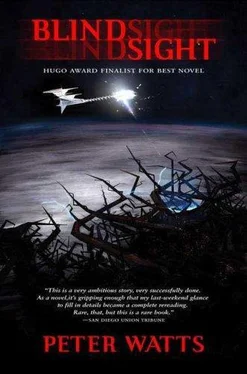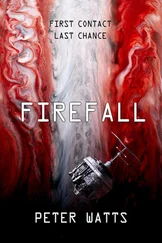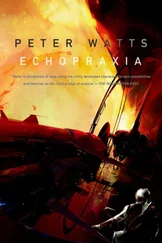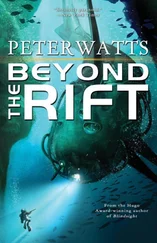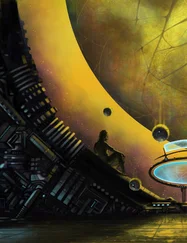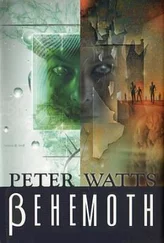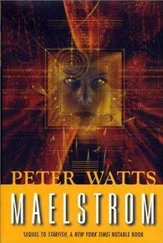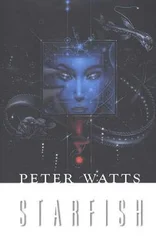“I feel sorry for the poor son of a bitch,” he said once, back in training.
Some would have thought that absurd. This man, so massively interfaced with machinery that his own motor skills had degraded for want of proper care and feeding; this man who heard x-rays and saw in shades of ultrasound, so corrupted by retrofits he could no longer even feel his own fingertips without assistance — this man could pity anyone else, let alone an infra-eyed predator built to murder without the slightest twitch of remorse?
“Empathy for sociopaths isn’t common,” I remarked.
“Maybe it should be. We, at least—” he waved an arm; some remote-linked sensor cluster across the simulator whirred and torqued reflexively — “ chose the add-ons. Vampires had to be sociopaths. They’re too much like their own prey — a lot of taxonomists don’t even consider them a subspecies, you know that? Never diverged far enough for complete reproductive isolation. So maybe they’re more syndrome than race. Just a bunch of obligate cannibals with a consistent set of deformities.”
“And how does that make—”
“If the only thing you can eat is your own kind, empathy is gonna be the first thing that goes. Psychopathy’s no disorder in those shoes, eh? Just a survival strategy. But they still make our skin crawl, so we — chain ’em up.”
“You think we should’ve repaired the Crucifix glitch?” Everyone knew why we hadn’t. Only a fool would resurrect a monster without safeguards in place. Vampires came with theirs built in: without his antiEuclideans Sarasti would go grand mal the first time he caught close sight of a four-panel window frame.
But Szpindel was shaking his head. “We couldn’t have fixed it. Or we could have,” he amended, “but the glitch is in the visual cortex, eh? Linked to their omnisavantism. You fix it, you disable their pattern-matching skills, and then what’s the point in even bringing them back?”
“I didn’t know that.”
“Well, that’s the official story.” He fell silent a moment, cracked a crooked grin. “Then again, we didn’t have any trouble fixing the protocadherin pathways when it suited us.”
I subtitled. Context-sensitive, ConSensus served up protocadherin γ-Y : the magical hominid brain protein that vampires had never been able to synthesize. The reason they hadn’t just switched to zebras or warthogs once denied Human prey, why our discovery of the terrible secret of the Right Angle had spelled their doom.
“Anyway, I just think he’s — cut off.” A nervous tic tugged at the corner of Szpindel’s mouth. “Lone wolf, nothing but sheep for company. Wouldn’t you feel lonely?”
“They don’t like company,” I reminded him. You didn’t put vampires of the same sex together, not unless you were taking bets on a bloodbath. They were solitary hunters and very territorial. With a minimum viable pred-prey ratio of one to ten — and human prey spread so sparsely across the Pleistocene landscape — the biggest threat to their survival had been competition from their own kind. Natural selection had never taught them to play nicely together.
That didn’t cut any ice with Szpindel, though. “Doesn’t mean he can’t be lonely,” he insisted.
“Just means he can’t fix it.”
“They know the music but not the words.”
—Hare,
Without Conscience
We did it with mirrors, great round parabolic things, each impossibly thin and three times as high as a man. Theseus rolled them up and bolted them to firecrackers stuffed with precious antimatter from our dwindling stockpiles. With twelve hours to spare she flung them like confetti along precise ballistic trajectories, and when they were safely distant she set them alight. They pinwheeled off every which way, gamma sleeting in their wake until they burned dry. Then they coasted, unfurling mercurial insect wings across the void.
In the greater distance, four hundred thousand alien machines looped and burned and took no obvious notice.
Rorschach fell around Ben barely fifteen hundred kilometers from atmosphere, a fast endless circle that took just under forty hours to complete. By the time it didn’t return to our sight, the mirrors were all outside the zone of total blindness. A closeup of Ben’s equatorial edge floated in ConSensus. Mirror icons sparkled around it like an exploding schematic, like the disconnected facets of some great expanding compound eye. None had brakes. Whatever high ground the mirrors held, they wouldn’t hold it for long.
“There,” Bates said.
A mirage wavered stage left, a tiny spot of swirling chaos perhaps half the size of a fingernail held at arms-length. It told us nothing, it was pure heat-shimmer — but light bounced towards us from dozens of distant relayers, and while each saw scarcely more than our last probe had — a patch of dark clouds set slightly awry by some invisible prism — each of those views refracted differently . The Captain sieved flashes from the heavens and stitched them into a composite view.
Details emerged.
First a faint sliver of shadow, a tiny dimple all but lost in the seething equatorial cloud bands. It had just barely rotated into view around the edge of the disk — a rock in the stream perhaps, an invisible finger stuck in the clouds, turbulence and shear stress shredding the boundary layers to either side.
Szpindel squinted. “Plage effect.” Subtitles said he was talking about a kind of sunspot, a knot in Ben’s magnetic field.
“Higher,” James said.
Something floated above that dimple in the clouds, the way a ground-effect ocean-liner floats above the depression it pushes into the water’s surface. I zoomed: next to an Oasa subdwarf with ten times the mass of Jupiter, Rorschach was tiny.
Next to Theseus , it was a colossus.
Not just a torus but a tangle , a city-sized chaos of spun glass, loops and bridges and attenuate spires. The surface texture was pure artifice, of course; ConSensus merely giftwrapped the enigma in refracted background. Still. In some dark, haunting way, it was almost beautiful. A nest of obsidian snakes and smoky crystal spines.
“It’s talking again,” James reported.
“Talk back,” Sarasti said, and abandoned us.
* * *
So she did: and while the Gang spoke with the artefact, the others spied upon it. Their vision failed over time — mirrors fell away along their respective vectors, lines-of-sight degraded with each passing second — but ConSensus filled with things learned in the meantime. Rorschach massed 1.8·10 10kg within a total volume of 2.3·10 8cubic meters. Its magnetic field, judging by radio squeals and its Plage Effect, was thousands of times stronger than the sun’s. Astonishingly, parts of the composite image were clear enough to discern fine spiral grooves twined around the structure. (“Fibonacci sequence,” Szpindel reported, one jiggling eye fixing me for a moment. “At least they’re not completely alien.”) Spheroid protuberances disfigured the tips of at least three of Rorschach ’s innumerable spines; the grooves were more widely spaced in those areas, like skin grown tight and swollen with infection. Just before one vital mirror sailed out of range it glimpsed another spine, split a third of the way along its length. Torn material floated flaccid and unmoving in vacuum.
“Please,” Bates said softly. “Tell me that’s not what it looks like.”
Szpindel grinned. “Sporangium? Seed pod? Why not?”
Rorschach may have been reproducing but beyond a doubt it was growing , fed by a steady trickle of infalling debris from Ben’s accretion belt. We were close enough now to get a clear view of that procession: rocks and mountains and pebbles fell like sediment swirling around a drain. Particles that collided with the artefact simply stuck ; Rorschach engulfed prey like some vast metastatic amoeba. The acquired mass was apparently processed internally and shunted to apical growth zones; judging by infinitesimal changes in the artefact’s allometry, it grew from the tips of its branches.
Читать дальше
